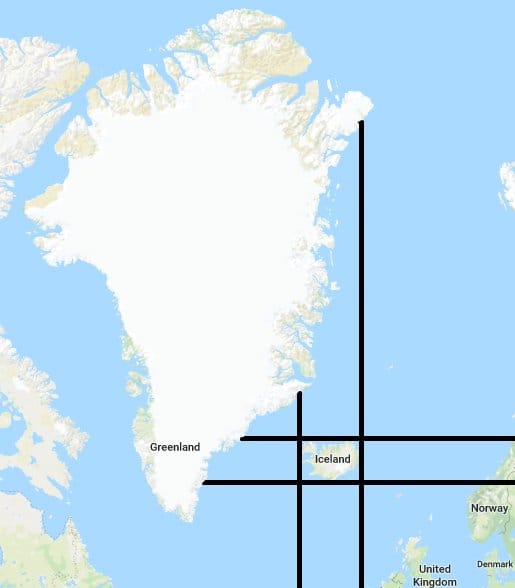Map by Reddit user etymologynerd
You’ve probably heard the old joke about Greenland and Iceland having backwards names. Greenland is icy, Iceland is green.
But here’s something that’ll really mess with your mental map: Greenland is actually farther north, south, east, and west than Iceland. Yes, all four directions. At once.
Take a moment. Let that sink in.
The Directional Mind-Bender
Looking at the map, this seems impossible at first glance. How can one landmass be more extreme in every cardinal direction than another? The answer lies in sheer size.
Greenland is absolutely massive, covering over 2.1 million square kilometers. Iceland, by comparison, is a relatively modest 103,000 square kilometers.
When something is that much larger, its extreme points can easily surpass a smaller neighbor in multiple directions simultaneously. Greenland stretches so far in every direction that its northernmost point beats Iceland’s north, its southern tip extends below Iceland’s south, and its eastern and western edges reach beyond Iceland’s boundaries, too.
Breaking Down the Compass
Let’s get specific. Greenland’s northern tip reaches up to Cape Morris Jesup at about 83 degrees north latitude, while Iceland’s northernmost point barely crosses 66 degrees. That’s a difference of roughly 1,200 miles.
Going south, Greenland’s Cape Farewell dips down to about 59 degrees north, while Iceland’s southernmost point sits at roughly 63 degrees. Even though both are still pretty far north by global standards, Greenland extends significantly farther toward the equator.
The east and west comparisons are equally striking. Greenland’s eastern coast pushes closer to Europe than any part of Iceland, while its western shores reach deeper into the North American side of the Atlantic.
Why This Matters (Sort Of)
Does this geographic trivia change your life? Probably not. But it’s a perfect example of how our mental maps can deceive us.
We tend to think of Iceland as the “middle” island between North America and Europe, with Greenland as the big northern chunk. The reality is more complicated and more interesting.
This kind of geographic awareness matters when we talk about climate patterns, shipping routes, geopolitics, and even wildlife migration. Both islands play crucial roles in Arctic ecosystems, and understanding their true positions helps us grasp the bigger picture of how our northern hemisphere works.
The Takeaway
Next time someone brings up Greenland and Iceland at a dinner party, you can casually drop this fact and watch the confusion spread across faces. Geography is full of these delightful surprises that challenge our assumptions. And in a world where we rely on GPS to tell us where we are, maybe it’s worth occasionally stopping to really understand where things actually sit on our planet.
Now you know: Greenland doesn’t just dwarf Iceland in size. It literally surrounds it directionally.
Help us out by sharing this map:
